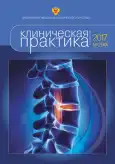ИННОВАЦИОННЫЕ ПОДХОДЫ К ВОССТАНОВИТЕЛЬНОМУ ЛЕЧЕНИЮ ПАЦИЕНТОВ ПОСЛЕ ИШЕМИЧЕСКОГО ПОЛУШАРНОГО ИНСУЛЬТА
- Авторы: Екушева Е.В.1, Кипарисова Е.С.1, Ширшова Е.В.1
-
Учреждения:
- ФГБОУ ДПО ИПК ФМБА России
- Выпуск: Том 8, № 2 (2017)
- Страницы: 28-33
- Раздел: Статьи
- URL: https://journals.rcsi.science/clinpractice/article/view/8073
- DOI: https://doi.org/10.17816/clinpract8228-33
- ID: 8073
Цитировать
Полный текст
Аннотация
Полный текст
Открыть статью на сайте журналаОб авторах
Евгения Викторовна Екушева
ФГБОУ ДПО ИПК ФМБА России
Email: ekushevaev@mail.ru
к.м.н., доцент кафедры нервных болезней и нейростоматологии ФГБОУ ДПО ИПК ФМБА России
Елена Сергеевна Кипарисова
ФГБОУ ДПО ИПК ФМБА Россиид.м.н., профессор кафедры нервных болезней и нейростоматологии ФГБОУ ДПО ИПКФМБА России
Елена Вениаминовна Ширшова
ФГБОУ ДПО ИПК ФМБА Россиид.м.н., профессор кафедры нервных болезней и нейростоматологии ФГБОУ ДПО ИПК ФМБА России
Список литературы
- Кадыков А.С., Черникова Л.А., Шахпаронова Н.В. Организация медико-социальной реабилитации больных. В кн.: Реабилитация неврологических больных. М., 2014; 12-16.
- Lawrence E.S., Coshall C., Dundas R. et al. Estimates of theprevalence of acute stroke impairments and disability in a multiethnic population. Stroke 2001; 22: 1279-1284.
- Connell L.A. Somatosensory impairment after stroke: frequency of different deficits and their recovery Clinical Rehabilitation 2008; 22(8): 758-767.
- Scalha T.B., Miyasaki E., Lima N.M. et al. Correlations between motor and sensory functions in upper limb chronic hemiparetics after stroke. Arquivos de Neuro-psiquiatria 2011; 69(4): 624-629.
Дополнительные файлы






